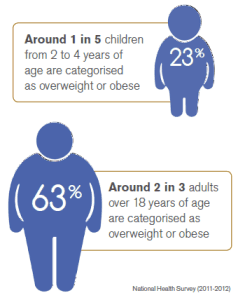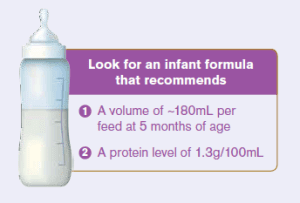Your guide to feeding volumes

For Formula-Fed Infants
Obesity Is On The Rise
We all want the best for our children, but with so much going on, getting the right nutritional balance can sometimes be a challenge. A chubby baby is often perceived as a healthy baby, when in fact the contrary is true. Early feeding can program their body for life, so it is important to establish healthy habits early before it becomes a bigger problem.

How Much Is Too Much?
It is important when choosing an infant formula to review the feeding guide and nutritional content on the back of the product, as these can vary significantly across formula brands.
Volume
Breastfeeding provides ideal nutrition for babies and may help reduce the risk of obesity later in life. A breastfed baby rarely consumes more than 180mL of breast milk per feed at 5 months of age. For formula-fed infants, research shows that the volume of milk in an infant’s bottle may be a contributor to overfeeding.
Protein
High protein intake in infant formula may be a contributor to weight gain in infancy.



Can you overfeed a baby?
Overfeeding is uncommon in breastfed babies, as they’re able to self-regulate the amount that they feed. Parents feeding with a bottle, however, are more likely to push their child to finish the bottle regardless of whether they’re full. Some parents add supplements to formula, which can also contribute to overfeeding. From the age of six months when solids are introduced, there are serving sizes parents can follow to prevent overfeeding. You can find the serving sizes here.
Establish Healthy Habits Early
If your baby receives formula some signs that your baby may have had enough include:
- Falling asleep
- Pushing away
- Closing lips tightly on the teat
- Opening or relaxing arms along the side of the body
- Arching back
- More interested in surroundings
- Opening hands, relaxing fingers.
Of course every baby is different, and growth spurts happen as well, so sometimes your baby may need more or less in a feed. You may also need to take other things into consideration when choosing an infant formula, such as special feeding needs.
Your healthcare professional can help you identify the most appropriate formula and feeding patterns for your child
Did You Know An Infant’s Stomach GROWS Over Time?
In early stages of a baby’s life they will consume small volumes of feeds more frequently. As they grow their stomach size increases.
Day One
A baby’s stomach is about the size of a cherry – 6mLs
Day Three
A baby’s stomach is about the size of a walnut – 25mLs
Day Ten
A baby’s stomach is about the size of a chicken egg – 71mLs
Month Three
A baby’s stomach is about the size of a small lemon – 175mLs
Adult
An adult’s stomach is the size of a grapefruit – 900mLs
AF05616







